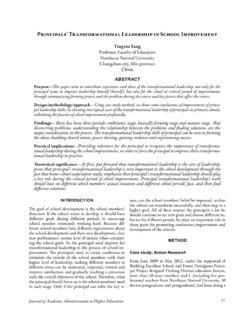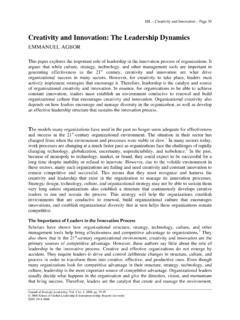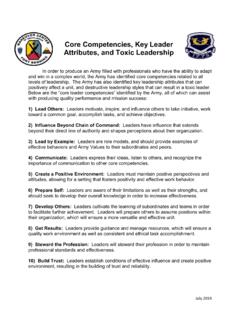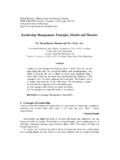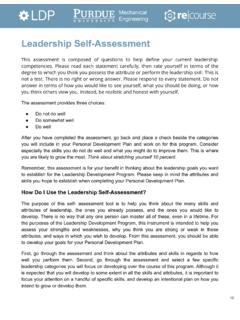Transcription of Distributed Leadership in Educational Institutions
1 Journal of Education and Training Studies Vol. 3, No. 4; July 2015 ISSN 2324-805X E-ISSN 2324-8068 Published by Redfame Publishing URL: 110 Distributed Leadership in Educational Institutions S leyman G ksoy Correspondence: S leyman G ksoy, Faculty of Education, Educational Sciences, Educational Administration and Supervision, University of D zce, 81620, D zce, Turkey Received: May 4, 2015 Accepted: May 21, 2015 Online Published: June 2, 2015 URL: Abstract In recent years, many studies are conducted about shared Leadership process. Distributed Leadership (DL) approach addresses Leadership along with teams, groups and organizational characteristics. In practice, this approach objects the supposition that an individual should take the lead in order to ensure change. Proponents of this idea claim that shared Leadership is required since Educational Institutions are too complex to be managed with only one individual.
2 Responsibility for managing various complex tasks in organizations is Distributed among a myriad of individuals with different roles. The basic principle advocated in this approach is based on the futility of efforts to ascertain a series of best single leader characteristics or best single leader behaviors. Current study aims to provide information on Distributed Leadership and discuss the applicability of the concept in Educational organizations. Keywords: Educational organizations, Leadership , Distributed Leadership 1. Introduction Although investigations on Leadership concept date back to Plato s The Republic written in 400 and thousands of studies, books and movies exist on the topic due to its importance which are designed to relate what is Leadership and how to be a good leader, there are still areas that are uncovered about the concept (Lunenburg & Ornstein, 2013). In definitions of traditional Leadership , Leadership is defined as the process of influencing a group to reach goals (Robbins, 1994).
3 That is to say, when observers are affected by a single individual in the realization of aims, it is claimed that Leadership process is in effect (Birdal & Aydemir, 1992) in this situation . Therefore, the essence of traditional Leadership process consists of one individual s effect on others (Ko el, 1999). Leader in this Leadership process is accepted as the person with the most or highest effect on the members of the group and defined as the individual with the highest impact on individuals or groups (Freadman, Sears & Carlsmith, 2003:539) and as the individual who leads others to act in a specific way for a specific purpose (Hitt et. al., 1975; Ert rk, 2000). Recent Distributed Leadership approach can be said to fully change even ignore the traditional Leadership and leader definitions since Leadership in Distributed Leadership approach has a more complex structure than Leadership behaviors (Harris & Lambert ,2003; Leithwood, Day et.)
4 Al, 2006). Leadership structure and effective Leadership practices are combined in four categories: identification of targets, development of individuals, reconstituting the organizational structure and improving teaching and Educational program (Malloy, 2012). Distributed Leadership is a result of reflecting the cognizance on organizational management regarding the view that Leadership roles and positions should be shared. That is to say, Distributed Leadership addresses the entirety of human resources in organizations, especially the academic staff in Educational organizations as leaders. According to this Leadership model, it is fundamental to develop Leadership potentials of human resources at schools and provide equal chances and statuses for the staff to realize the goals of the school. The basic philosophy underlining this approach is the mobilization of shared wisdom and common sense by creating synergy among the staff at organizations and maximization of organizational efficiency, productivity and competence which will ensure achievement and happiness in the members of the organization.
5 Distributed Leadership model regards the management and operations of organizations in general and school organizations in particular as complex and complicated processes. Therefore, school management, which is a complicated and hard task, cannot be left to a single leader or Leadership approach or potential because school structures are not easy to be managed effectively with the Leadership of a single person. Developmental Process of Leadership Approaches Starting with the second half of the 20th century, scientific studies on Leadership have focused on the characteristics that Journal of Education and Training Studies Vol. 3, No. 4; 2015 111 separate leaders from non-leaders and leaders from their followers (Hoy & Miskel,2012) and effective leaders from ineffective leaders.
6 Trait theory, the first of Leadership theories, proposes the behaviors that separate leaders from non-leaders (Robbins & Judge, 2012). Studies have presented many personal characteristics of leaders (Bass, 1990). In fact, the main element that highlights a single person as the leader is the personal characteristics. Especially the psychological and physiological properties of the leader have become the focus of these studies ( i man, 2002; elik, 1999; Erdo an, 1991; Stogdill, 1948, 1981; Immegart, 1988). In the 70 s, there was still no consensus as a result of trait theory about constant personality and physical properties of a leader that would be pertinent in all situations (K z lo lu, Tabak, Erkeneli, 2012). Behavioral theory which seeks the answer to the question What makes a leader effective? in types of leader behaviors started to attract researchers attention since the 70s.
7 Studies in the realm of behavioral approaches generally focus on Leadership behaviors, Leadership styles as behavioral patterns and their potential effects of groups (Er etin, 2000). According to behavioral Leadership theory, attitudes and behaviors of leaders towards their followers are crucial for success. Based on this theory, Leadership is a behavioral process in role systems. The leader mainly depends on the resources of persons, feels responsibility towards these individuals and utilizes interactions with them to obtain the desired outcome.(Werner, 1993). In the theory, Leadership behaviors are based on two different dimensions. While one dimension is related to individuals, interpersonal interactions and the continuity of the group, the other is based on production orientation and realization of goals (Cartwright & Zander, 1953).
8 Therefore, the approach includes Leadership styles that focus on interpersonal relationships, consider personal needs of staff and regard differences among members and the Leadership styles that focus on the technique and content of tasks (Robbins and Judge, 2012). The last two theories in Leadership theories are contingency/situational Leadership and full-range theory of Leadership . In situational Leadership theory, it is believed that circumstances require different Leadership styles and situations create the leader (Hoy & Miskel, 1991). Contingency theories purport that there is not a single Leadership style that is effective in all cases and Leadership style changes according to situations (Arun, 2008). Situational/contingency theory which states that it is impossible to predict effective Leadership behaviors for different situations and that there is not a single most effective Leadership style for all cases ( im ek, 2010; elik, 1999) aims to identify the distinctive characteristics of environments that may be the source of leader success and to distinguish between the characteristics of Leadership situations related to leader behavior and leader performance (Campbell et.)
9 Al., 1970; Lawler, 1985; Vecchio, 1993). Contingency either increase or limits the effect of the leader (Hoy & Miskel,2012). From a different standpoint, contingency theory should also focus on the audience. Contingency theories assume that selection of Leadership style based on the characteristics of the task that the audience desires or the perceptions of audience will determine the success levels of the leader (Robbins & Judge, 2012). 1. 2 Modern Leadership Approaches and Distributed Leadership Almost a hundred new Leadership theories were developed or proposed in the last phase in Leadership studies which is addressed as modern/new or full-range Leadership theories. The main modern Leadership theories include implicit Leadership , strategic Leadership , online Leadership , selfleadership, servant Leadership , authentic Leadership , transformational Leadership , charismatic Leadership , synergic Leadership , substituted Leadership , mentoring, transactional Leadership (Bass, 1985; Lunenburg and Ornstein, 2013; Hoy and Miskel,2012; Tabak, e en,T rk z, 2012), shared Leadership (Bak r, 2013; Bostanc , 2012), Distributed Leadership (Spillane & Diamond, 2007; Gronn, 2002; Balo lu, 2011; Korkmaz & G nd z, 2011; zer & Beycio lu, 2013; Hulpia, Devos & Rosseel, 2009; zdemir, 2012; Elmore, 2000), ethical Leadership , cultural Leadership , instructional Leadership , learning Leadership , visionary Leadership , charismatic Leadership ( elik, 1999; i man, 2002).
10 Situational Leadership and newer Leadership theories explain the distribution og Leadership functions with concepts such as Distributed cognition (Halverson, Clifford, 2013; Brown, 1989), democratic Leadership (Bass, 1990), shared Leadership (Kocolowski, 2010; Judge & Ryman, 2001; Sergiovanni, 1995) and selfleadership (Charles, 1986; U urluo lu, 2010). Distributed cognition (Halverson, Clifford, 2013; Brown, 1989) is another theory related to Distributed Leadership according to Printty (2008) and it represents collective intellect. Here, knowledge, skill or expertise is more than the sum of individualistic knowledge and abilities. There is a possible choreography comprehended collectively which creates the group intellect. This is sometimes called organizational knowledge and sometimes it is addressed as learning. The concept expresses the expansion of knowledge across people and cases.











